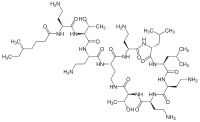 | |
 | |
| Clinical data | |
|---|---|
| Trade names | Xylistin, Coly-Mycin M, Colobreathe, others |
| AHFS/Drugs.com | Monograph |
| MedlinePlus | a682860 |
| License data | |
| Routes of administration | Topical, by mouth, intravenous, intramuscular, inhalation |
| ATC code | |
| Legal status | |
| Legal status | |
| Pharmacokinetic data | |
| Bioavailability | 0% |
| Elimination half-life | 5 hours |
| Identifiers | |
| |
| CAS Number | |
| PubChem CID | |
| DrugBank | |
| ChemSpider | |
| UNII |
|
| KEGG | |
| ChEMBL | |
| CompTox Dashboard (EPA) | |
| ECHA InfoCard | 100.012.644 |
| Chemical and physical data | |
| Formula | C52H98N16O13 |
| Molar mass | 1155.455 g·mol−1 |
| 3D model (JSmol) | |
| |
| |
| | |
Colistin, also known as polymyxin E, is an antibiotic medication used as a last-resort treatment for multidrug-resistant Gram-negative infections including pneumonia.[7][8] These may involve bacteria such as Pseudomonas aeruginosa, Klebsiella pneumoniae, or Acinetobacter.[9] It comes in two forms: colistimethate sodium can be injected into a vein, injected into a muscle, or inhaled, and colistin sulfate is mainly applied to the skin or taken by mouth.[10] Colistimethate sodium[11] is a prodrug; it is produced by the reaction of colistin with formaldehyde and sodium bisulfite, which leads to the addition of a sulfomethyl group to the primary amines of colistin. Colistimethate sodium is less toxic than colistin when administered parenterally. In aqueous solutions, it undergoes hydrolysis to form a complex mixture of partially sulfomethylated derivatives, as well as colistin. Resistance to colistin began to appear as of 2015.[12]
Common side effects of the injectable form include kidney problems and neurological problems.[8] Other serious side effects may include anaphylaxis, muscle weakness, and Clostridioides difficile-associated diarrhea.[8] The inhaled form may result in constriction of the bronchioles.[8] It is unclear if use during pregnancy is safe for the fetus.[13] Colistin is in the polymyxin class of medications.[8] It works by breaking down the cytoplasmic membrane, which generally results in bacterial cell death.[8]
Colistin was discovered in 1947 and colistimethate sodium was approved for medical use in the United States in 1970.[9][8] It is on the World Health Organization's List of Essential Medicines.[14] The World Health Organization classifies colistin as critically important for human medicine.[15] It is available as a generic medication.[16] It is derived from bacteria of the genus Paenibacillus.[10]
- ^ "Drug Product Database". Health Canada. 25 April 2012. Retrieved 13 January 2022.
- ^ "Colobreathe 1,662,500 IU inhalation powder, Hard Capsules – Summary of Product Characteristics (SmPC)". (emc). Retrieved 16 November 2020.
- ^ "Colomycin 1 million International Units (IU) Powder for solution for injection, infusion or inhalation – Summary of Product Characteristics (SmPC)". (emc). 27 May 2020. Retrieved 16 November 2020.
- ^ "Promixin 1 million International Units (IU) Powder for Nebuliser Solution – Summary of Product Characteristics (SmPC)". (emc). 23 September 2020. Retrieved 16 November 2020.
- ^ "Coly-Mycin M- colistimethate injection". DailyMed. 3 December 2018. Retrieved 16 November 2020.
- ^ "Colobreathe EPAR". European Medicines Agency. 17 September 2018. Retrieved 16 November 2020.
- ^ Pogue JM, Ortwine JK, Kaye KS (April 2017). "Clinical considerations for optimal use of the polymyxins: A focus on agent selection and dosing". Clinical Microbiology and Infection. 23 (4): 229–233. doi:10.1016/j.cmi.2017.02.023. PMID 28238870.
- ^ a b c d e f g "Colistimethate Sodium Monograph for Professionals". Drugs.com. Retrieved 6 November 2019.
- ^ a b Falagas ME, Grammatikos AP, Michalopoulos A (October 2008). "Potential of old-generation antibiotics to address current need for new antibiotics". Expert Review of Anti-Infective Therapy. 6 (5): 593–600. doi:10.1586/14787210.6.5.593. PMID 18847400. S2CID 13158593.
- ^ a b Bennett JE, Dolin R, Blaser MJ, Mandell GL (2009). Mandell, Douglas, and Bennett's Principles and Practice of Infectious Diseases E-Book. Elsevier Health Sciences. p. 469. ISBN 9781437720600.
- ^ Bergen PJ, Li J, Rayner CR, Nation RL (June 2006). "Colistin methanesulfonate is an inactive prodrug of colistin against Pseudomonas aeruginosa". Antimicrobial Agents and Chemotherapy. 50 (6): 1953–1958. doi:10.1128/AAC.00035-06. PMC 1479097. PMID 16723551.
- ^ Hasman H, Hammerum AM, Hansen F, Hendriksen RS, Olesen B, Agersø Y, et al. (2015-12-10). "Detection of mcr-1 encoding plasmid-mediated colistin-resistant Escherichia coli isolates from human bloodstream infection and imported chicken meat, Denmark 2015". Euro Surveillance. 20 (49): 30085. doi:10.2807/1560-7917.ES.2015.20.49.30085. PMID 26676364.
- ^ "Colistimethate (Coly Mycin M) Use During Pregnancy". Drugs.com. Retrieved 11 November 2019.
- ^ World Health Organization (2019). World Health Organization model list of essential medicines: 21st list 2019. Geneva: World Health Organization. hdl:10665/325771. WHO/MVP/EMP/IAU/2019.06. License: CC BY-NC-SA 3.0 IGO.
- ^ World Health Organization (2019). Critically important antimicrobials for human medicine (6th revision ed.). Geneva: World Health Organization. hdl:10665/312266. ISBN 9789241515528.
- ^ British national formulary : BNF 76 (76 ed.). Pharmaceutical Press. 2018. p. 547. ISBN 9780857113382.